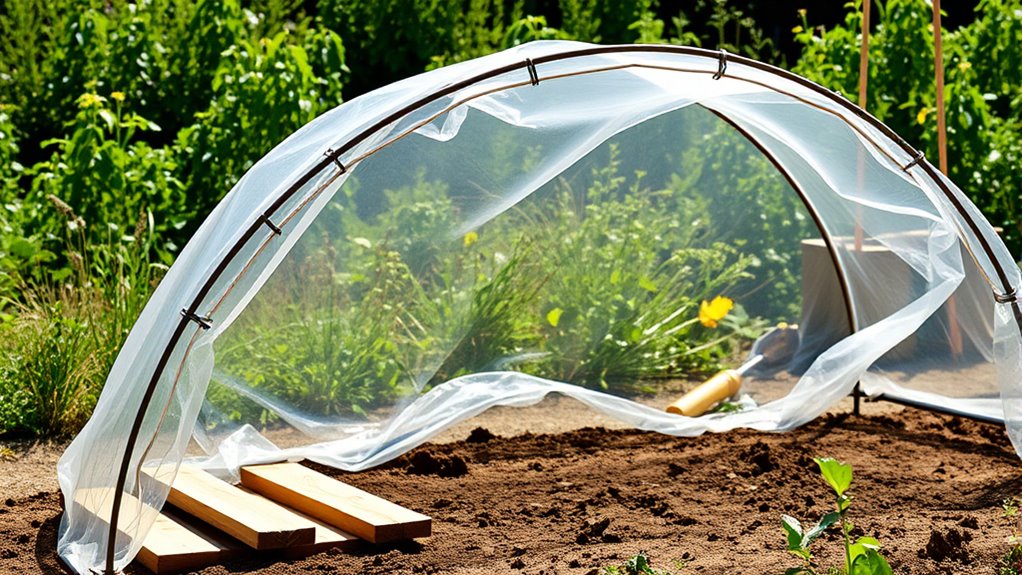To build a low-cost hoop house, start by selecting affordable, durable materials for the frame, like PVC pipes or bent metal, and guarantee all openings are sealed to prevent pests. Clear weeds and debris from the site, loosen the soil, and mix in compost or manure to boost fertility. Use simple pest control methods such as physical barriers and beneficial insects, and maintain proper ventilation. Keep your setup tidy and monitor environmental conditions to promote healthy plants. Continue exploring these tips to learn more.
Key Takeaways
- Use affordable, durable materials for the hoop house framework, such as PVC pipes or bent rebar.
- Properly prepare soil by clearing weeds, adding compost, and testing pH to ensure healthy plant growth inside the hoop house.
- Incorporate simple pest control measures like physical barriers, insect screens, and beneficial insects to protect crops cost-effectively.
- Ensure good ventilation and sealing of openings to prevent pests and maintain optimal environmental conditions.
- Keep the workspace tidy and maintain basic tools to minimize pest habitats and facilitate easy construction and maintenance.

Creating a low-cost hoop house is a practical way to extend your growing season without breaking the bank. Before you set up the structure, you need to focus on soil preparation. Healthy soil is the foundation for thriving plants, so take the time to clear the area of weeds and debris. Loosen the soil with a garden fork or tiller, and incorporate compost or well-rotted manure to boost fertility. Proper soil prep ensures your plants have the nutrients they need and helps retain moisture, which is especially important in a hoop house where environmental conditions can be controlled but not entirely managed. You might also consider testing your soil’s pH and adjusting it if necessary, to match the specific needs of your crops. Good soil preparation reduces the risk of disease and pests, giving your plants a better start. Using quality vacuum cleaners to keep your workspace tidy can also help prevent pest issues and maintain a healthy environment.
Once your soil is ready, you can turn your attention to pest control. A hoop house can create a microclimate that’s more susceptible to pests if not managed properly. To keep pests at bay, start with a clean setup—remove weeds and debris around the structure that might harbor insects or rodents. Use physical barriers like row covers or insect screens on vents and openings to prevent pests from entering. Regularly inspect your plants for signs of trouble, such as holes in leaves or discolored spots, so you can catch issues early. Beneficial insects, like ladybugs and predatory beetles, can also be introduced to naturally control pest populations. Keep the interior of your hoop house tidy and avoid overwatering, as damp conditions can attract pests and promote disease. Applying organic pest control methods, like neem oil or insecticidal soap, can help manage infestations without harming beneficial insects or the environment.
Building your hoop house with affordable materials keeps costs low, but don’t skimp on the essentials of soil prep and pest control. These steps are key to ensuring a successful growing season. When your soil is properly conditioned, your plants will grow stronger and resist pests better. Implementing simple, low-cost pest control strategies creates a healthy environment where your crops can flourish. With a bit of effort upfront, your low-cost hoop house becomes a sustainable, productive space that extends your gardening possibilities. This approach not only saves money but also promotes healthier plants and a more enjoyable gardening experience. By paying attention to soil preparation and pest management, you set yourself up for a successful, bountiful harvest and a longer growing season that doesn’t strain your budget.
Frequently Asked Questions
How Durable Is a Low-Cost Hoop House in Harsh Weather?
A low-cost hoop house can handle harsh weather if you choose durable fabric with good longevity and guarantee proper wind resistance. While it may not withstand extreme storms as long as more expensive structures, regular maintenance and reinforced supports help increase its durability. Expect it to last several seasons if you address potential wear early. Overall, with proper care, it provides a resilient, affordable option for protecting your plants in tough conditions.
Can a Hoop House Be Used Year-Round in Cold Climates?
Yes, you can use a hoop house year-round in cold climates. Imagine lush greens thriving even in winter’s chill, thanks to seasonal extension and smart insulation techniques. You’ll want to add extra insulation, like blankets or bubble wrap, and consider a heating source for the coldest months. With these adjustments, your hoop house becomes a cozy haven for plants, no matter how frosty outside.
What Are the Best Materials for DIY Hoop House Frames?
You should consider material alternatives and framing options like galvanized steel, PVC pipes, or even bent rebar for your DIY hoop house frames. Galvanized steel offers durability, while PVC pipes are lightweight and easy to work with. Rebar can be bent into arches for a sturdy, cost-effective frame. Choose materials based on your climate, budget, and ease of assembly to guarantee your hoop house is both strong and affordable.
How Much Can I Expect to Save Compared to a Traditional Greenhouse?
You’ll save a ton—literally—by choosing a DIY hoop house over a traditional greenhouse. Expect a significant cost comparison favoring your wallet, often cutting expenses in half or more. Long-term savings come from lower construction costs, minimal maintenance, and DIY materials. So, you’ll not only enjoy fresh veggies faster but also keep more cash in your pocket, proving that cheap can be cheerful—and surprisingly effective.
Are There Any Safety Concerns With Building a Hoop House?
Yes, there are safety concerns when building a hoop house. You should conduct hazard identification to spot potential risks like sharp tools, unstable frames, or improper anchoring. Follow safety precautions such as wearing gloves, eye protection, and sturdy footwear. Make sure to secure all materials properly and work on stable ground. Taking these steps helps prevent injuries and guarantees your hoop house construction is safe and successful.
Conclusion
So, after all that effort, you’ve built a cheap hoop house that could outlast some expensive greenhouses. Irony? It’s probably the most cost-effective way to boost your garden’s productivity, yet many overlook the simple solution. Who knew that a few pipes and plastic could beat pricey equipment? Now, you’ve got a thriving garden on a budget, proving sometimes, the best things in life—and gardening—are pretty inexpensive. Happy planting!










